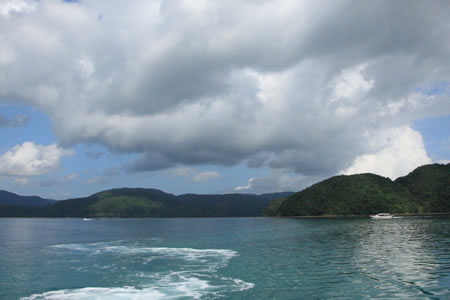An island cat and an ingenious bird
By Vivek Menon, Executive Director WTI, author,
environmental commentator and an optimist
Japan’s Iriomote island, the lone home of the critically endangered
Iriomote cat. Photo by: Vivek Menon
All island ecosystems are interesting because many things you see there are not found anywhere else in the world. Iriomote has its share of birds, mammals and reptiles that are endemic to the two dozen or so small islands that lie strung out in the Pacific. Iriomote is so far from the main island of Japan that it is closer to Taiwan. The first Okinawan I had ever seen was a Cathay Pacific air hostess in the 70s who looked so unlike an Asian that I took her to be a Hawaiian. And when I saw my first Iriomote cat, it was so unlike a leopard cat that I almost mistook it for a common grey tabby. If I was not primed for seeing it, if a 500 mm lens was not resting for half a day on my arms waiting for it, I would have thought it was a quick domestic feline that had jumped across the road. But the road that cut through a swathe of Iriomote forest had no villages near it. There were no domestic cats. And the Iriomote cat was so quick that it took off from a clump of grass on the fringe of the road and walked into tall bushes on to the far side in something that approximated ten seconds. It was the middle of the night and only the headlights that fell on it partially defined it. But with that tantalising glimpse in the dark of the world’s most elusive cat, I could claim to be part of Japanese folklore..those who had seen the cat!
Maki San a shy and knowledgable scientist is the only PHD on the Iriomote cat. She runs a remarkable centre that includes a good interpretation centre, a host of scientific programmes and a huge rehabilitation centre, that in the middle of the island with its air conditioned operating theatre and massive high-walled enclosures stands testimony to the dedication and resources that Japan does put into saving whatever little remains of their natural world. But meeting Maki San is interesting not for her descriptions of the animal, not even for her guided tour that had me almost falling into her rehab cage, but for her ingenious passage way under the main highway that she has constructed for the cats. Every now and then she has supervised and constructed a fascinating remedy for road hits, a sad consumer of the wild cat in Iriomote. If a tiny Pacific island of Iriomote can do that for a wild tabby, can’t India do a few for our elephants and tigers? We have much to learn….
Iriomote cats dying in road hits. Photo by: Vivek Menon
If the cat was the astounding AHA moment of the trip, the bird was the most photographed. On one of the Iriomote islands we stayed in a small home turned into motel. The owner had a fascinating companion and a story. After our meal on the snails of the island, he made us collect the shells and throw them at a specific place on the island. In minutes, hordes of hermit crabs walked in from the sea, picked up the empty shells and placed them like turban on their heads and tried to march away back to their burrows. In flew a resident ruddy kingfisher (the subspecies is another island endemic). Its bright ruddy coat and red lipstick bill flashing in the dusk, it picked crab after crab and banging the shell first this way and then that on a strategically placed branch consumed half a dozen before flying away. I believe it did this twice a day with regularity. The bird may have eaten a dozen crabs in two stints. I may have taken 200 snaps. Crab-eating monkeys breaking coconut shells in the Nicobars, chimpanzees using a stick to fish out termites at Gombe, elephants picking the very leaf that they want from a clump of thorny bamboo culms…animals using their brains to get what they want, always fascinates me. In Maki San I saw a human being using her ingenuity to save wildlife; in the ruddy kingfisher I saw the bird using its own survival skills. I wonder what the hermit crabs will evolve to doing in order to survive. I would want to visit sometime later to find out.









